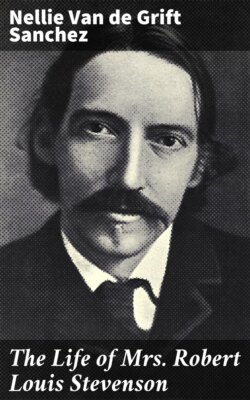Читать книгу The Life of Mrs. Robert Louis Stevenson - Nellie van de Grift Sanchez - Страница 10
ОглавлениеThe Van de Grift residence at the corner of Illinois and Washington Streets, Indianapolis.
All too soon came the time when these days of careless childish joys were brought to a close. A new era opened, and romance, which budded early in that time and place, began to unfold its first tender leaves. Various youths of the town, attracted by the piquant prettiness and sparkling vivacity of the eldest daughter, began to haunt the Van de Grift house. In the sentimental fashion of the day, these sighing swains carved her name on the trees, and so wide was the circle of her fascination that there was scarcely a tree in the place that did not bear somewhere on its long-suffering trunk the name or initials of Fanny Van de Grift. None of these suitors, however, made any impression on the object of their attentions, who was so much of a child that she was walking on stilts in the garden when Samuel Osbourne first called at the house. He was an engaging youth, a Kentuckian by birth, with all the suavity and charm of the Southerner. Behind him lay a truly romantic ancestry, for, through John Stewart, who was stolen and brought up by the Indians, and never knew his parentage, he was a collateral descendant of Daniel Boone.[4]
On December 4, 1857, in a house on Michigan Street, which had already been prepared and furnished for their occupancy, Samuel Osbourne, aged twenty, and Fanny Van de Grift, aged seventeen, were united in marriage. All the notables of the town, including Governor Willard, to whom young Osbourne was private secretary, and the entire staff of State officers, attended. The young bride looked charming in a handsome gown of heavy white satin, of the kind that "could stand alone," of the "block" pattern then in vogue, and made in the fashion of the day, with full long-trained skirt and tight low-necked bodice trimmed with a rich lace bertha. Her hair was worn in curls, fastened back from the face on each side. The groom, who is seldom mentioned in these affairs, deserves a word or two, for he made a gallant figure in a blue coat with brass buttons, flowered waistcoat, fawn-coloured trousers, strapped under varnished boots, and carrying a bell-topped white beaver hat. One who was a guest at the wedding says, "They looked like two children," as indeed they were. It was a boy-and-girl marriage of the kind people entered into then with pioneer fearlessness, to turn out well or ill, as fate decreed.
The young couple took up their residence in the same house in which they were married, and before the young husband was twenty-one years old their first child, Isobel, was born. The little mother was so small and young-looking that once when she was on a railroad-train with her infant an old gentleman, looking at her with some concern, asked: "Sissy, where is the baby's mother?"
It was now that the great black storm-cloud which had been hovering over the nation for years broke in all its fury upon this border State. The Osbournes, together with nearly all their friends and relatives, cast in their lot with the North, and young Osbourne left his family and went to the war as captain in the army.
We must now return to the dark, handsome boy, George Marshall, once the favourite playmate and now the brother-in-law of Fanny Van de Grift. He, too, joined the colours, in command of a company of Zouaves whom he had himself gathered and trained. After a time spent in active service on some of the hardest fought battle-fields of the Civil War, the hardships and exposure of the life told upon a constitution never at any time robust, and he returned to his young wife a victim of tuberculosis. The doctors said his only chance was to get to the milder climate of California, and at the close of the war Samuel Osbourne, who was his devoted friend, gave up position and prospects to accompany him thither. The two young men, leaving their families behind them, took ship at New York for Panama; but the Angel of Death sailed with them, and Captain Marshall breathed his last while crossing the Isthmus.
Osbourne decided to go on to California, and on his arrival there was so pleased with the country that he wrote to his wife to sell her property at once and follow him. Bidding a long farewell to the loving parents who had up to that time stood between her and every trouble, Fanny Osbourne, at an age when most young women are enjoying the care-free life of irresponsible girlhood, took her small daughter Isobel and set forth into a new and strange world.
Crossing the Isthmus by the crookedest railroad ever seen, she stopped at Panama to visit the burial-place of the young soldier, George Marshall, her childhood playmate, beloved friend, and brother-in-law, and over that lonely grave the child for the first time saw her girlish mother shed tears.[Back to Contents]
